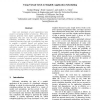Free Online Productivity Tools
i2Speak
i2Symbol
i2OCR
iTex2Img
iWeb2Print
iWeb2Shot
i2Type
iPdf2Split
iPdf2Merge
i2Bopomofo
i2Arabic
i2Style
i2Image
i2PDF
iLatex2Rtf
Sci2ools
IPPS
2006
IEEE
2006
IEEE
Using virtual grids to simplify application scheduling
Users and developers of grid applications have access to increasing numbers of resources. While more resources generally mean higher capabilities for an application, they also raise the issue of application scheduling scalability. First, even polynomial time scheduling heuristics may take a prohibitively long time to compute a schedule. Second, and perhaps more critical, it may not be possible to gather all the resource information needed by a scheduling algorithm in a scalable manner. Our application focus is scientific workflows, which can be represented as Directed Acyclic Graphs (DAGs). Our claim is that, in future resource-rich environments, simple scheduling algorithms may be sufficient to achieve good workflow performances. We introduce a scalable scheduling approach that uses a abstraction called a virtual grid (VG). Our simulations of a range of typical DAG structures and resources demonstrate that a simple greedy scheduling c combined with the virtual grid abstraction is as ...
Application Scheduling Scalability | Distributed And Parallel Computing | IPPS 2006 | Scheduling Algorithms | Time Scheduling Heuristics |
| Added | 11 Jun 2010 |
| Updated | 11 Jun 2010 |
| Type | Conference |
| Year | 2006 |
| Where | IPPS |
| Authors | Richard Y. Huang, Henri Casanova, Andrew A. Chien |
Comments (0)

